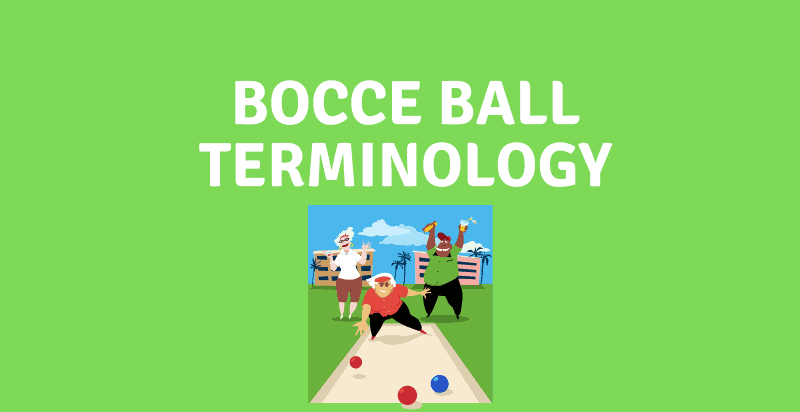Like all the other sports we cover on our site, Bocce has a lot of terminology. And since Bocce was created/invented in Italy, it can at times appear even more difficult to learn the lingo and terminology.
But if you take a few minutes to learn some of these terms, you will understand the game better. And like with all games, the more you know the more comfortable you will feel playing the game. And the more fun you will have and then you will likely get better and it will be more fun.
At the end of the day, it’s all about fun! So we wrote this article for you and hope understanding the terms and lingo will help improve your bocce ball game.
Bocce Ball Terminology and Lingo
Here are the most popular bocce ball terms you need to know.
Advantage – In bocce ball terminology, the first team that gets to throw the pallino has an “advantage” or a “pallino advantage” over the other team. The first team has the freedom to place the pallino wherever they want in the court and they also have a clear shot at throwing the first bocce ball.
Backboards – Sometimes the backboards are also referred to as end boards or the back walls. The backboards are the shorter court walls that are at the opposite ends of a bocce ball court.
Bank Shot – This is a shot in which you throw the ball so that it hits the sideboards and bounces against it to move as close to the pallino as possible. You can also refer to this shot as “banking.” This is very similar to how the term is used in billiards when referring to a bank shot on the pool table.
Bocce – Bocce is the name of the sport and is the plural form of boccia (the Italian term for ball). We’ve discussed the origin of the term in detail in our previous post exploring what is bocce. You could further learn about the origin of the sport in our post where we discuss the history of bocce.
Bocce Balls – Bocce balls are the eight colorful balls used to play bocce. The goal of the game is to roll these balls and try to get them as close to the pallino as possible to score points. Unlike petanque, bocce uses colorful balls – mainly blue and red. There are many options for different types and styles of bocce balls.
Dead Ball – The ball becomes dead when the it is disqualified because of a technicality or infringement.
Doubles – A doubles game involves two teams playing against each other with two players in each team. So there will be a total of four players for this game. Just like with tennis sometimes people refer to this as pairs instead of doubles.
End – More commonly known as a “frame” or a “round,” an end is a period of the game in which all players have taken their turns. The official will award points to the scoring team for that end before starting another end.
Foul – This is typically a foot or a line foul and involves a player violating the bocce ball game rules. The most common fouls are usually either stepping over the foul line, or releasing the ball after crossing the foul line. The team that commits the foul will receive a penalty based on the type and frequency of the foul.
Foul Line – A foul line in bocce ball terminology is the line in a court that a player should not cross before releasing the ball. Players must remain behind the foul line regardless of whether they’re playing a pointing shot or a hitting shot.
Fours – A game in which there are two teams playing against each other, with four players in each team. So there will be a total of eight players for this game. Some people refer to this as a “teams game.”
Half Court Marker – A half court marker is a line or marker that divides the court exactly in half, which is common in most sports that involve a court. Typically, this would be a line drawn on the court surface halfway between the two backboards of the court.
Hitting – In bocce ball lingo, hitting is a shot that involves hitting other balls on the court in an attempt to displace them. These shots are typically forceful, since the player’s intent is to move the ball to the far end of the court. Others may also refer to this with other terms like “shooting,” “popping,” or “spocking.”
Inbound Lines – These lines define the 12-inch boundary that the pallino must not cross during the initial throw.
Initial Point – The initial point refers to the first ball that you roll towards the pallino at the beginning of a frame. As it is the first ball, it is also closest to the pallino at that moment. As a result, it establishes the initial point of that frame. The player that tosses the pallino should also make the first roll to establish the initial point.
In Team – The in team refers to the team that has their ball closest to the pallino and holds the point. They will continue to be the in team for that frame unless the opposition gets ahead. If that occurs, then the other team becomes the in team.
Jack – Also known as a “pallino,” a jack is the smaller white ball that’s thrown at the beginning of each game. It may also come in other colors such as yellow or even metallic. The objective of the game is to get your balls as close to this jack as possible in order to earn points for the frame.
Kiss – Some people also call this by its Italian name baci. It refers to a situation in which a bocce ball is touching or “kissing” the pallino. The Italians are romantic in general and these concepts carry over to the game.
Lagging – This is the basic throw in which a player tries to roll the ball as close to the pallino as possible. People sometimes refer to this as pointing too. The general concept here is to gently roll the ball toward the pallino. This is the simplest, most straightforward way to play – and a great approach for beginners who are just learning how to play bocce.
Live Ball – A live ball refers to any ball that is legitimate and in play. It is also referred to as a “good ball.”
Measure – When you measure the distance between the bocce balls and the pallino to determine which of them will get to score for that frame. This comes in handy when two or more balls appear to be in the same distance from the pallino. In this case, you’ll need to measure which of them is actually closer to the pallino.
No Point – A no point is also known as a tie and this occurs when the closest balls from the two teams are at an equal distance from the pallino. In this case, the team that delivered the last ball will have to re-attempt their throw. If all the balls have been played for that frame, neither team is awarded a point.
Out Team – As opposed to the in team, the out team is the team whose ball is farther from the pallino and does not hold the point at that moment. They will continue to be the out team until one of their balls surpasses their opponent’s closest ball and they eventually become the in team.
Penalty – This is where you’ll find similarities between bocce ball glossary and other sport terms. A penalty in bocce refers to the consequence of committing a foul or violating a game rule. A penalty may be against a team or against a specific player.
Rule of Advantage – A rule of advantage refers to the option that a team gets when their opponents commit a foul. The team will get to make a choice depending on their ball position and the state of the game.
Sideboards – Sideboards refer to the boards that enclose the length of the court to keep the balls from rolling out of court. They are typically 6-12 inches high.
Singles – A singles game, also known as a one-on-one game, is a game involving two players who are playing against each other.
Social Bocce – Social bocce is a term for casual bocce games among a group of people. Typically, people will get together and form temporary teams for the day. It doesn’t involve tournament play or scheduled league plays and is solely for fun.
Team – A team on a bocce ball court can have a maximum of four players and a minimum of two players.
Tournament – Like with other sports, a bocce ball tournament involves several teams playing matches over a certain period of time. Losing teams are eliminated until the final team remains and they are the winner of the tournament.
Unified – This is bocce ball terminology used in the Special Olympics and refers to a game in which an equal number of Unified Partners and Special Olympics athletes play on the same team. The Unified Partner should have an equal ability to the Special Olympics athlete they’re partnering with.
Volo – Volo refers to a long, hard throw (into the air) so that your bocce ball lands beyond the center line. The main goal of this throw is to spock another ball. However, volo is generally not permitted in court bocce because you could end up damaging the court surface or breaking other bocce balls.
Rules aside, it is a rather egregious etiquette faux pas if you damage your friend’s expensive bocce ball set as a result of a high solo!
And it could also be a safety risk for other players. Especially if you are having afternoon cocktails with your summertime bocce ball game. So make sure you check with your host if you are having a friendly game if a volo is acceptable to them.
Video – Bocce Ball Terminology
This is an excellent video that gives you a walk through of the terminology and lingo we wrote about above. Sometimes its helpful to see this content in a video, so give it a watch and you will learn some new things for sure.
Summary
These are some of the most common bocce ball terms for you to know to improve your understanding of game.
In our experience if you understand more slang and the game lingo, you will feel more comfortable while you are playing. And you will have more fun, play more often and get better.
And if this has inspired you to get a new Bocce Ball set be sure to check out our Ultimate Buying Guide to the Best Bocce Ball sets.

I’m Lia and I love playing games. I started this site to share things with friends and they encouraged me to post more and now I’m trying to share things with the world – indoor and outdoor sports, and board and bar games. I write about things like Bocce, Croquet, Billiards, Darts and other fun ways to enjoy time with your friends and family!



